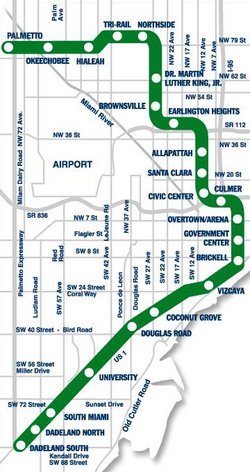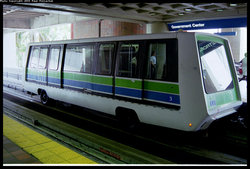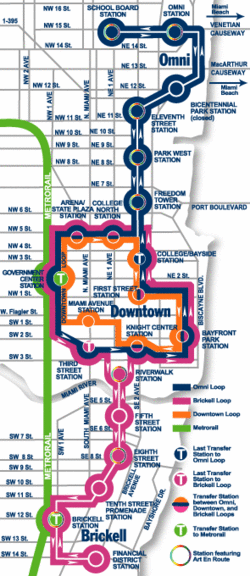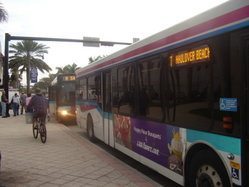|
|
|
|
Locale
|
Miami, Florida
|
|
Transit type
|
Rapid transit
|
|
Began operation
|
20-May-84
|
|
System length
|
34 mi (43 km)
|
|
No. of lines
|
4
|
|
No. of stations
|
43
|
|
Daily ridership
|
267,700 daily
|
|
Track gauge
|
1,435 mm (4 ft 8½ in) (standard gauge)
|
|
Operator
|
Miami-Dade Transit
|
|
Miami-Dade Transit is the public transit authority in Miami-Dade County, Florida. It is the largest transit system in Florida, and one of the largest in the U.S. It currently operates the Metrorail, Metromover, Metrobus, and Paratransit (STS) systems.
History
In 1960, the Dade County Commission passed an ordinance creating the Metropolitan Transit Authority (MTA) to unify the different transit operations into one countywide service. This ordinance provided for the purchase, development, and operation of an adequate mass transit system by the County. These companies included the Miami Transit Company, Miami Beach Railway Company, South Miami Coach Lines, and Keys Transit Company on Key Biscayne and would be managed by National City Management Company. Over the years and under various administrations, MTA evolved into the Metro-Dade Transportation Administration, the Metro-Dade Transit Agency, the Miami-Dade Transit Agency, and is now known simply as Miami-Dade Transit (MDT).
Miami-Dade Transit, a county department of more than 4,000 employees, is the largest transit agency in the state of Florida and provides more than 50% of the trips taken on public transit in the state. MDT operates an accessible, integrated system of 100-plus Metrobus routes; the 22-mile Metrorail heavy rail system; Metromover, a downtown people mover system; and the Paratransit division’s Special Transportation Service. Metrobus routes cover more than 35-million miles annually, including limited service to Broward and Monroe counties. In 2004, MDT's Metrorail, Metromover, and Metrobus transported more than 96 million passengers, compared to 85 million the previous year.
Fares
- The current standard fare on Miami-Dade Transit is $1.50 (Local)/$1.85 (Express), and reduced fare is $0.75 (Local)/$0.90 (Express), and a standard monthly pass costs $75 (Full Fare)/$37.50 (Reduced Fare). Terms and conditions are stated below.
- On Metrobus, the fare box accepts tokens, dollar bills, quarters, dimes, and nickels, or a monthly pass to be shown to the bus operator. The monthly Metropass and tokens are sold at over 50 sales outlets. Metrorail fare gates accept tokens, Susan B. Anthony or Sacajawea dollar coins, quarters, dimes, nickels, bus-to-rail transfers, and monthly passes, the Patriot Passport, and the Golden Passport. Metromover is free for all riders. Enter any station through the fare gate. Reduced fares are available only to Medicare recipients, people with disabilities, and Miami-Dade students in grades 1-12. Transit fare equipment does not provide change, but change/token machines are found in all rail stations.
- All Miami-Dade senior citizens 65 years and older and Social Security beneficiaries ride free with a Golden Passport. Veterans residing in Miami-Dade and earning less than $22,000 annually ride free with the Patriot Passport.
Metrorail
|
Metrorail
|

|
|
|
|
|
Locale
|
Miami, Florida
|
|
Transit type
|
Rapid transit
|
|
Began operation
|
20-May-84
|
|
System length
|
27.4 mi (43 km)
|
|
No. of lines
|
1
|
|
No. of stations
|
22
|
|
Daily ridership
|
62,300
|
|
Track gauge
|
1,435 mm (4 ft 8½ in) (standard gauge)
|
|
Operator
|
Miami-Dade Transit
|
|
Metrorail currently operates on a 27.4 mile rapid transit line. It began service on May 20, 1984 servicing Dadeland South north to Overtown/Arena stations. Following, the rest of the stations were opened in two additional phases: in December 1984 and May 1985. The most recent addition to the line, Palmetto station, opened in May 2003. There are an average 61,300 Metrorail boardings daily.
Hours of operation
Metrorail runs regularly from 5 a.m. until midnight seven days a week. Trains arrive every six minutes during weekday rush hours, every 8-10 minutes at midday, and every 15-30 minutes after 6 p.m. until midnight. Weekend service runs every 15 minutes until approximately 8 p.m., then every 30 minutes until midnight. Between midnight and 5 a.m., trains arrive every 60 minutes.
A limited-stop bus route, the Route 500 Midnight Owl, operates hourly between 12:30 a.m. and 5:30 a.m. (with a special northbound trip between Dadeland South and Gov't Center/Downtown Miami on Fridays and Saturdays only), stopping at or near Metrorail stations or transfer points between the Palmetto and Dadeland South Metrorail stations. This bus service replaces 24-hour Metrorail service that was put into place for a brief period after the implementation of the half-penny sales tax initiative, but cancelled due to lack of ridership.
Train and track information
Metrorail runs from the northwest in Medley through Hialeah, into the city of Miami, the downtown area, through Coral Gables and South Miami, and ending in southwest Miami-Dade at Dadeland Mall. There are 22 accessible Metrorail stations, one about every 1.25 miles (or 1.9 kilometers). Metrorail connects to the Metromover system at Government Center and Brickell stations and to South Florida's Tri-Rail suburban system at the Tri-Rail/Metrorail transfer station(see below).
Trains are stored at the Palmetto Yard just west of Okeechobee Station. The yard houses 136 cars built by the now-defunct Budd corporation. Each car's capacity is 166 passengers; each train's top speed is 58 miles per hour. On the 27.4 miles of track are 9 crossovers: between Dadeland South and Dadeland North, between University and Douglas Road *, between Vizcaya and Brickell *, Culmer (east of the station), between Brownsville and Dr. Martin Luther King Jr Plaza, Northside (east of the station), Okeechobee (both east and west of the station), and Palmetto (east of the station). (* Indicates crossovers which contain a length of center track capable of storing a 6 car trainset.) Palmetto Yard just west of Okeechobee Station. The yard houses 136 cars built by the now-defunct Budd corporation. Each car's capacity is 166 passengers; each train's top speed is 58 miles per hour. On the 27.4 miles of track are 9 crossovers: between Dadeland South and Dadeland North, between University and Douglas Road *, between Vizcaya and Brickell *, Culmer (east of the station), between Brownsville and Dr. Martin Luther King Jr Plaza, Northside (east of the station), Okeechobee (both east and west of the station), and Palmetto (east of the station). (* Indicates crossovers which contain a length of center track capable of storing a 6 car trainset.)
Along the Metrorail system, the tracks are mostly elevated. Three sections are not: between Vizcaya and Brickell stations, between Overtown/Arena and Culmer stations, and just east of Palmetto station. In each of these cases, the tracks ride on ground level or underground for a brief amount of time.
The platform at each Metrorail station is long enough to accommodate six-car-long trains; the Dadeland North and Government Center station platforms are long enough to accommodate eight-car-long trains. In-service trains are usually either four or six cars long; in the evening it is not uncommon for Miami-Dade Transit to link two out-of-service trains together before returning them to the Palmetto Yard.
Future plans
Immediate plans are in place to extend the Metrorail network to Miami International Airport, Florida International University and Dolphin Stadium (see Other projects). By 2014, the Metrorail will serve the Miami Intermodal Center in addition to west Miami-Dade and north central Miami-Dade County. Currently, the connecting Tri-Rail transit line is the only way to access the airport. Additional more long-term plans exist to extend metrorail to Miami Beach, western Kendall, and Aventura.
Stations
Palmetto
Okeechobee
Hialeah
Tri-Rail*
Northside
Dr. Martin Luther King, Jr., Plaza
Brownsville
Earlington Heights
Allapattah
Santa Clara
Civic Center
Culmer (Bus stops at NW 7 Ave only)
Overtown/Arena
Government Center**
Brickell**
Vizcaya
Coconut Grove
Douglas Road
University
South Miami
Dadeland North
Dadeland South
Future stations
215th Street
199th Street
183rd Street
163rd Street
119 Street
82nd Street
Ali Baba*
Central Station*
Red Road
Waterford
Milam Dairy Road
Galloway Road
97th Avenue
FIU
(* - Transfer to Tri-Rail Here)
(** - Transfer to Metromover Here)
Metromover
Metromover is a free people mover train system that serves Downtown Miami from Omni to Brickell and connects with Metrorail at Government Center and Brickell stations. It originally began service to the Downtown Loop on April 17, 1986. The Omni and Brickell extensions (see below) opened May 26, 1994. a free people mover train system that serves Downtown Miami from Omni to Brickell and connects with Metrorail at Government Center and Brickell stations. It originally began service to the Downtown Loop on April 17, 1986. The Omni and Brickell extensions (see below) opened May 26, 1994.
There are 21 conveniently located accessible Metromover stations located throughout Downtown Miami. Metromover links many of Downtown Miami's major office buildings, residential buildings, hotels, and retail centers, the Steph
|
Metromover
|

|
|
|
|
|
Locale
|
Miami, Florida
|
|
Transit type
|
People mover
|
|
Began operation
|
17-Apr-86
|
|
System length
|
4.4 mi (7.1 km)
|
|
No. of lines
|
3
|
|
No. of stations
|
21
|
|
Daily ridership
|
28,300
|
|
Operator
|
Miami-Dade Transit
|
|
en P. Clark Government Center, the Cultural Plaza (Miami Art Museum, Historical Museum, Main Library), and the Brickell Financial District.
Running clockwise, the Downtown (Inner) Loop serves all downtown stations except Third Street station. The Outer Loop (Brickell and Omni Loops) runs counterclockwise around the downtown area servicing all stations except for Miami Avenue Station. The Brickell loop runs a line into the Brickell area to the south of downtown, while the Omni Loop contains a line with stations in the Midtown Miami area to the north of downtown.
Hours
The loops run from 5 a.m. to midnight, seven days a week. The Outer Loop operates on a continuous loop from 7 p.m. to midnight, seven days a week. This schedule is adjusted during events. Trains arrive every 90 seconds during rush hours and every three minutes otherwise.
Metromover stations
Downtown Loop (Inner Loop)
- Government Center
- Miami Avenue*
- Knight Center**
- Bayfront Park
- First Street
- College/Bayside
- College North
- Arena/State Plaza
Omni Loop
- School Board
- Omni/Metromover Bus Terminal
- Bicentennial Park***
- Eleventh Street
- Park West
- Freedom Tower
- Third Street****
Brickell Loop
- Third Street****
- Riverwalk
- Fifth Street
- Eighth Street
- Tenth Street/Promenade
- Brickell
- Financial District
(* - Miami Avenue station serves the Downtown Loop only. All other Inner Loop stations serve all three Metromover loops.)
(** - originally World Trade Center station)
(*** - Bicentennial Park station closed October 28, 1996.)
(**** - originally Fort Dallas Park station, Third Street station serves both Omni and Brickell Loops)
Metrobus
The Metrobus network provides bus service throughout Miami-Dade Count y 365 days a year. It consists of more than 100 routes and 900 buses, which connect most points in the county and part of southern Broward County as well. Twenty-one (21) of these routes operate around the clock: most other routes operate from 4 AM to 2 AM. y 365 days a year. It consists of more than 100 routes and 900 buses, which connect most points in the county and part of southern Broward County as well. Twenty-one (21) of these routes operate around the clock: most other routes operate from 4 AM to 2 AM.
All Metrobuses are wheelchair accessible, in compliance with the Americans with Disabilities Act of 1990.
Along U.S. Route 1 in southern Miami-Dade, Metrobus service uses an exclusive right-of-way called the South Miami-Dade Busway.
South Miami-Dade Busway
|
Metrobus
|

|
|
|
|
|
Locale
|
Miami, Florida
|
|
Transit type
|
Bus, Bus rapid transit
|
|
No. of lines
|
112
|
|
Daily ridership
|
267,700
|
|
Operator
|
Miami-Dade Transit
|
|
The South Miami-Dade Busway (originally the South Dade Busway) began operating on February 3, 1997 and was extended in April 2005 (a second, 6.5 mile extension to SW 344 Street is in the development stage and is slated to open in 2007). It is an alternative to daily traffic congestion. The 13-mile roadway was built by the Florida Department of Transportation just for Metrobus routes and emergency vehicles. Express buses on the exclusive lanes shuttle passengers to and from Dadeland South Station (see Metrorail) in under 40 minutes.
Both full-size buses and minibuses operate on the Busway and in adjacent neighborhoods, entering the exclusive lanes at major intersections. Local and limited-stop service is offered between Florida City and Dadeland South Metrorail Station. Park & Ride lots along the busway are located at SW 152d Street (Coral Reef Drive), SW 168th Street (Richmond Drive), and SW 244th Street. At Dadeland South Station, riders transfer to Metrorail. Riders headed downtown can transfer from Metrorail to Metromover, which consists of three shorter downtown loops, at Government Center Station.
The South Miami-Dade Busway has 22 sheltered stations and several unsheltered bus stops. Each station contains up-to-date transit information (maps, schedules, brochures) with newspapers, benches, and public phones added for customer comfort and convenience. Additionally, a multi-use path stretches the length of the Busway.
The Busway has been the site of many accidents, as some car drivers driving south on US-1 (which runs parallel to the Busway for much of its length), and looking to turn west, do not stop at the red arrows that govern the right turn lane at an intersection that has a Busway crossing adjacent to it. They make a right turn and go right into the path of a bus that is entering the adjacent Busway intersection. Buses currently have to slow down to 15 mph before crossing the intersection, and the police often patrol the intersections looking for red arrow runners. Surprisingly, even the intersections where the Busway runs as far as 2 blocks west of US-1 suffer the same problem, with car drivers either not seeing or flatly ignoring the red lights at SW 184th and 186th Streets.
Paratransit (STS)
Paratransit/Special Transportation Services (STS) is available for people with a mental or physical disability that cannot ride Metrobus, Metrorail, or Metromover. For $2.50 per one-way trip, STS offers shared-ride, door-to-door travel in accessible vehicles throughout most of Miami-Dade County, in some parts of south Broward County, and in the middle and northern Keys . STS operates 24 hours a day, seven days a week, including most holidays.
Back to the Top |
|